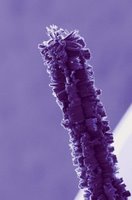Nanotube, heal thyself, Atomic blemishes move, repairing molecular skin in their wake
The research appears Feb. 16 issue of in Physical Review Letters.
Carbon nanotubes are hollow cylinders of pure carbon that measure about a billionth of a meter, or one nanometer, across. They are much longer than they are wide, akin in shape to 100-foot garden hose, and they're 100 times stronger than steel at one-sixth the weight.
The carbon atoms in nanotubes are joined together in six-sided hexagons, so when scientists sketch out the arrangement on paper, nanotubes look something like a rolled up tube of chicken wire. Yakobson's "smart repair machine" is a deformity, a blemish in this pattern. The blemish consists of a five-sided pentagon joined to a seven-sided heptagon and contains a total of ten atoms. Yakobson, who specializes in using computers to decipher the atomic pecularities of materials, discovered several years ago that mechanically stressed nanotubes – like those being pulled very hard from both ends – are predisposed to develop these 5/7-defects due to the complex interplay of thermodynamic forces at work in the nanotube.
| In the latest study, Yakobson, research associate Feng Ding and students examined the effects of other types of stress, including exposure to heat and radiation. The tests confirmed the predisposition of nanotubes to develop the 5/7 blemishes, and they revealed the blemishes' unexpected healing powers. |
Yakobson said the blemishes consume all larger defects, and chug along indefinitely, rearranging atoms and healing the skin of the damaged nanotubes. This explains how nanotubes retain their strength, even when severely damaged. But the healing comes with a price.
"In their role as a safety valve, the 5/7-steamers give off energy and mass, which is released as pairs of gaseous carbon atoms," Yakobson said. "Since they never change shape or stop moving, they ever so slowly eat away the surface of the nanotube, one pair of atoms at a time."
Yakobson said the 5/7-blemishes turn when they reach the end of the nanotube and return in the opposite direction. In fact, there's only one thing that can stop them: another 5/7 blemish. If two of the blemishes run headlong into one other, they cancel each other out and disappear.
Research co-authors include graduate students Kun Jiao and Mingqi Wu.
The research was supported by the Office of Naval Research, the National Science Foundation and the Robert A. Welch Foundation.
02/15/2007, Rice University CONTACT: Jade Boyd, PHONE: 713-348-6778, E-MAIL: jadeboyd@rice.edu, IMAGE CREDIT: Rensselaer/Swastik Kar, Usage Restrictions: Include credit line.
Technorati Tags: nanofibers or Nanoscientists and Nano or Nanotechnology and nanoparticles or Nanotech and nanotubes or nanochemistry and nanoscale or nanowires and Nanocantilevers or nanometrology and Nanomachines or carbon nanotubes and nanofiltration or Rice University















No comments:
Post a Comment